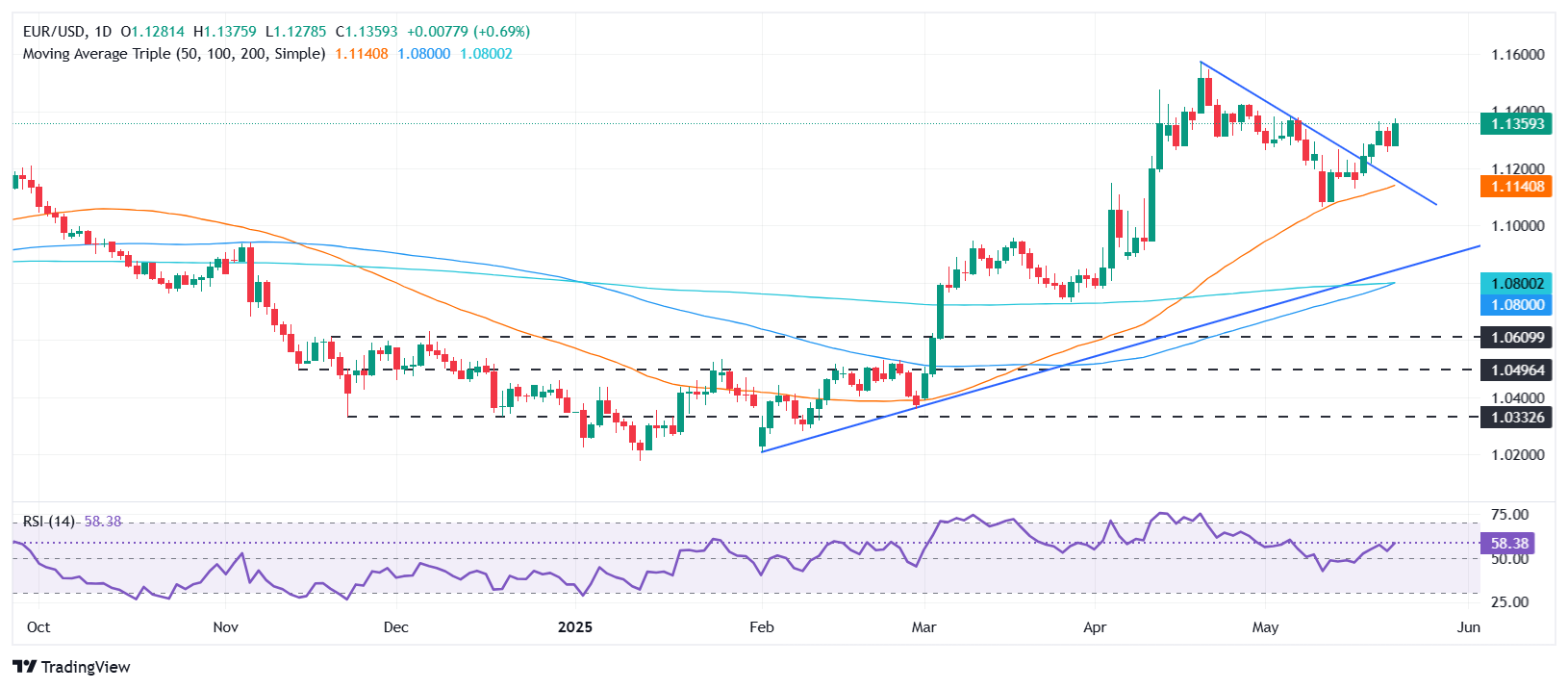EUR/USD rebounds back above 1.1300 after Trump tariffs shock sparks volatility
- EUR/USD dips to 1.1296 after Trump announces steep tariffs on EU imports starting June 1.
- The pair rebounds to 1.1350 as US Dollar stays pressured by rising fiscal deficit concerns.
- Euro shrugs off ECB rate cut talk, supported by improving German GDP figures.
EUR/USD recovered during the mid-North American session on Friday after diving below 1.1300 after US President Donald Trump rattled the markets by threatening to impose 50% tariffs on the European Union (EU). At the time of writing, the pair recovered and climbed to around 1.1350
US President Donald Trump posted on his social network early Friday that discussions with the European Union “are going nowhere! Therefore, I am recommending a straight 50% tariff on the European Union, starting on June 1, 2025,” he wrote. The EUR/USD fell to 1.1296 on the remarks before the uptrend resumed.
Following those remarks, US Treasury Secretary Scott Bessent said that “EU proposals have not been of good quality,” adding that “Most countries are negotiating in good faith, except the EU.”
The Greenback remains on the back foot, weighed down by the approval of Trump’s tax bill in the House of Representatives, which is on its way to the Senate. If passed, the proposal would add close to $4 trillion to the US debt ceiling over a decade, according to the Congressional Budget Office (CBO).
It is worth noting that the US Dollar remains unreactive to Federal Reserve (Fed) speakers, who so far have said the US Treasury market is working orderly, adding that uncertainty about supply chains, inventory and inflation keeps business executives unaware of the future.
The US economic docket featured US housing data in May, which was mixed as Building Permits fell, but New Home Sales improved in April.
In the Eurozone, Germany's Gross Domestic Product (GDP) improved yearly, though it remained in contractionary territory.
In the meantime, the Euro shrugged off speculation that the European Central Bank (ECB) is expected to lower interest rates at the upcoming meeting. ECB’s Rehn and Stournaras favor a rate cut in June, with the latter supporting a pause after that meeting.
EUR/USD daily market movers: the Euro favored by “sell America” trend
- The Euro remains favored by overall US Dollar weakness. The US Dollar Index (DXY), which tracks the performance of six currencies against the American Dollar, tumbled 0.79% at 99.10, its lowest level since April 29.
- The “sell America” trend continues with investors selling off bonds, US equities and the US Dollar. It was ignited by US President Donald Trump's “trade war” and Moody’s downgrade of US government debt from AAA to AA1.
- The US schedule featured Building Permits, which fell by 4% MoM in April, declining from 1.481 million to 1.422 million, signaling a slowdown in future construction activity.
- New Home Sales surged 10.9% MoM, rising from 0.67 million to 0.743 million, according to the US Census Bureau. This reflects strong demand in the housing market despite tighter supply conditions.
- Germany’s economy grew in Q1 2025, exceeding estimates due to exports and industry frontloading ahead of US tariffs. The Gross Domestic Product (GDP) improved from 0.2% to 0.4% QoQ.
EUR/USD technical outlook: Set to challenge 1.1400 in the near term
The EUR/USD uptrend resumed on Friday, with the pair reaching a two-week high of 1.1375 as traders brace for challenging 1.1400. Buyers are gathering steam as the pair registered the highest high and low during the last five days, and further confirmed by the Relative Strength Index (RSI), which trends up ahead of turning overbought.
If EUR/USD clears 1.1400, it would pave the way for testing key resistance levels, like 1.1450, followed by the 1.1500 mark and the year-to-date (YTD) high at 1.1573.
Conversely, if EUR/USD falls below 1.1300, the pair could test the May 22 low of 1.1255, ahead of 1.1200.

Euro FAQs
The Euro is the currency for the 19 European Union countries that belong to the Eurozone. It is the second most heavily traded currency in the world behind the US Dollar. In 2022, it accounted for 31% of all foreign exchange transactions, with an average daily turnover of over $2.2 trillion a day. EUR/USD is the most heavily traded currency pair in the world, accounting for an estimated 30% off all transactions, followed by EUR/JPY (4%), EUR/GBP (3%) and EUR/AUD (2%).
The European Central Bank (ECB) in Frankfurt, Germany, is the reserve bank for the Eurozone. The ECB sets interest rates and manages monetary policy. The ECB’s primary mandate is to maintain price stability, which means either controlling inflation or stimulating growth. Its primary tool is the raising or lowering of interest rates. Relatively high interest rates – or the expectation of higher rates – will usually benefit the Euro and vice versa. The ECB Governing Council makes monetary policy decisions at meetings held eight times a year. Decisions are made by heads of the Eurozone national banks and six permanent members, including the President of the ECB, Christine Lagarde.
Eurozone inflation data, measured by the Harmonized Index of Consumer Prices (HICP), is an important econometric for the Euro. If inflation rises more than expected, especially if above the ECB’s 2% target, it obliges the ECB to raise interest rates to bring it back under control. Relatively high interest rates compared to its counterparts will usually benefit the Euro, as it makes the region more attractive as a place for global investors to park their money.
Data releases gauge the health of the economy and can impact on the Euro. Indicators such as GDP, Manufacturing and Services PMIs, employment, and consumer sentiment surveys can all influence the direction of the single currency. A strong economy is good for the Euro. Not only does it attract more foreign investment but it may encourage the ECB to put up interest rates, which will directly strengthen the Euro. Otherwise, if economic data is weak, the Euro is likely to fall. Economic data for the four largest economies in the euro area (Germany, France, Italy and Spain) are especially significant, as they account for 75% of the Eurozone’s economy.
Another significant data release for the Euro is the Trade Balance. This indicator measures the difference between what a country earns from its exports and what it spends on imports over a given period. If a country produces highly sought after exports then its currency will gain in value purely from the extra demand created from foreign buyers seeking to purchase these goods. Therefore, a positive net Trade Balance strengthens a currency and vice versa for a negative balance.

